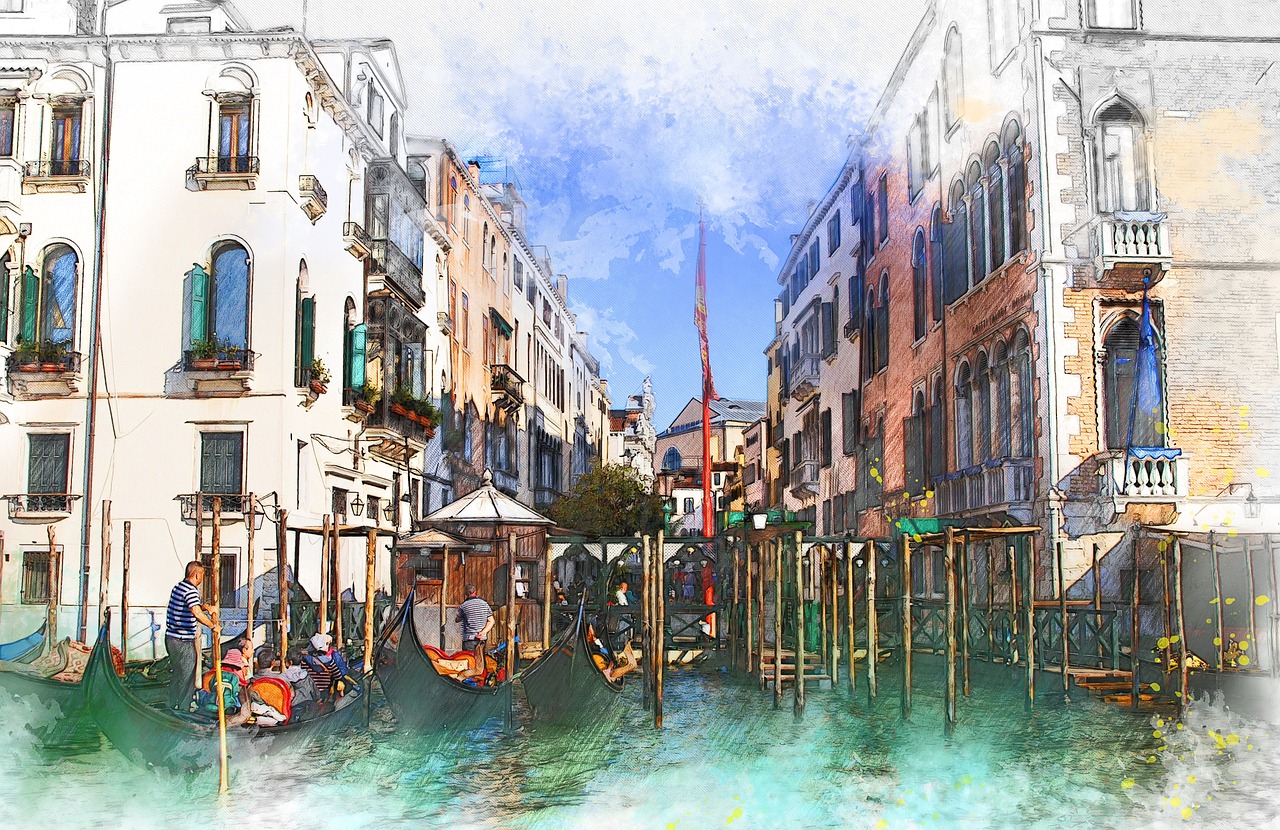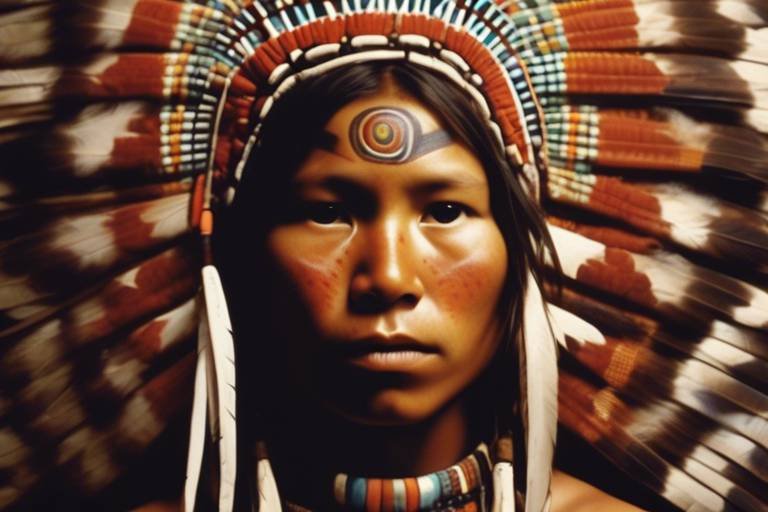The Impact of Digital Art on Traditional Forms
Digital art has revolutionized the traditional forms of artistic expression, creating a seismic shift in the art world. The fusion of digital and physical art forms has opened up a realm of possibilities for artists, challenging conventional boundaries and redefining the very essence of art itself. As technology continues to advance at a rapid pace, the impact of digital art on traditional forms is becoming increasingly profound and far-reaching.

Evolution of Artistic Techniques
Artistic techniques have undergone a significant evolution with the advent of digital tools and software. Artists now have a vast array of digital resources at their disposal, enabling them to create and manipulate images in ways that were previously unimaginable. The traditional methods of painting, sculpting, and drawing have been complemented and, in some cases, replaced by digital techniques that offer new possibilities for artistic expression.
One of the key aspects of this evolution is the shift from physical to digital mediums. Artists can now work on digital canvases, using tools that simulate traditional artistic materials such as brushes, pencils, and paints. This transition has blurred the boundaries between digital and physical art forms, opening up a realm of possibilities for artists to experiment with new styles and techniques.
Moreover, digital art has introduced the concept of non-destructive editing, allowing artists to make changes to their work without altering the original piece. This flexibility has revolutionized the creative process, enabling artists to explore different ideas and iterations without the fear of ruining their artwork.
Additionally, the integration of digital tools has democratized the artistic process, making it more accessible to a wider audience. Artists no longer need expensive materials or studio space to create art; all they need is a computer and the right software. This accessibility has paved the way for a new generation of artists from diverse backgrounds to enter the art world and contribute their unique perspectives.
Overall, the evolution of artistic techniques through digital art has transformed the way artists approach their work, pushing the boundaries of creativity and innovation. By embracing digital tools and techniques, artists can explore new artistic horizons and redefine traditional practices in exciting and unexpected ways.

Accessibility and Democratization
Exploring how digital art is reshaping traditional artistic practices and challenging the boundaries between digital and physical art forms.
Accessibility and democratization are two key aspects of digital art that have transformed the art world in profound ways. With the advent of digital tools and software, creating art has become more accessible to a wider audience than ever before. Artists no longer need expensive supplies or specialized training to express their creativity. The democratization of art has empowered individuals from diverse backgrounds to engage in artistic practices, breaking down barriers and fostering a more inclusive art community.
Moreover, digital platforms and online galleries have provided artists with a global stage to showcase their work, reaching audiences across continents in an instant. This unprecedented level of accessibility has not only revolutionized the way art is created and shared but has also democratized the art world by giving voice to marginalized communities and underrepresented artists.
By embracing digital tools, artists can experiment with new techniques, styles, and mediums, pushing the boundaries of traditional art forms. The democratization of art through digital platforms has opened up endless possibilities for creative expression, allowing individuals to explore their artistic potential without constraints.
Furthermore, the accessibility of digital art has sparked collaborations among artists from different parts of the world, leading to the creation of innovative artworks that blend cultural influences and diverse perspectives. This collaborative approach not only enriches the artistic process but also fosters a sense of community and shared creativity among artists globally.
In conclusion, the accessibility and democratization of digital art have revolutionized the art world, making creativity more inclusive, diverse, and interconnected than ever before. As digital art continues to evolve, its impact on traditional forms will only grow, challenging artists to explore new possibilities and redefine the boundaries of artistic expression.

Challenges and Criticisms
Exploring how digital art is reshaping traditional artistic practices and challenging the boundaries between digital and physical art forms.
When delving into the realm of digital art, one cannot ignore the challenges and criticisms that come along with this innovative medium. One of the primary concerns raised by critics is the issue of authenticity. Traditional art forms have a long-standing history and cultural significance, leading some to question the legitimacy of digital artworks in comparison. The debate over originality also arises, with skeptics questioning the uniqueness and creative process involved in digital art creation.
Moreover, the preservation of traditional artistic values is another point of contention. Critics argue that the rapid advancement of digital tools may overshadow the time-honored techniques and craftsmanship that define traditional art forms. The fear of losing the essence and soul of art in the digital age is a valid concern that continues to be debated among artists and art enthusiasts.
Additionally, the digital medium poses challenges in terms of reproduction and distribution. The ease of replicating digital artworks raises questions about ownership rights, copyright issues, and the value of originality in a digital landscape flooded with endless copies and duplicates. The struggle to maintain the exclusivity and integrity of digital art pieces remains a pressing issue in the art world.
Despite these criticisms and challenges, digital art continues to push boundaries and redefine artistic expression in unprecedented ways. By addressing these concerns and fostering dialogue between traditional and digital artists, the art world can evolve and adapt to the changing landscape of creativity and innovation.

Integration of Digital and Traditional Media
When it comes to the integration of digital and traditional media in the art world, we witness a fascinating blend of old and new techniques coming together to create innovative and boundary-pushing artworks. Artists are increasingly exploring the possibilities that arise from combining digital tools and traditional artistic practices, leading to a redefinition of artistic boundaries and the creation of truly unique pieces.
One of the key aspects of this integration is the seamless merging of digital and physical elements within a single artwork. Artists are using digital software to enhance traditional mediums such as painting, sculpture, and printmaking, adding layers of complexity and depth to their creations. This fusion of digital and traditional media allows for a level of experimentation and creativity that was previously unimaginable, opening up new avenues for artistic expression.
Moreover, the integration of digital and traditional media is not just limited to the creation process but also extends to the presentation and exhibition of artworks. Digital platforms and virtual galleries have provided artists with new ways to showcase their pieces, reaching a global audience and breaking down geographical barriers. This shift towards digital exhibition spaces has revolutionized the way art is experienced and consumed, offering viewers a dynamic and interactive viewing experience.
Furthermore, the integration of digital tools has democratized the art-making process, making it more accessible to a wider range of artists. With the availability of affordable software and online resources, artists from diverse backgrounds and skill levels can now experiment with digital techniques and incorporate them into their practice. This inclusivity has led to a rich tapestry of artistic styles and approaches, reflecting the diversity and vibrancy of the contemporary art scene.
In conclusion, the integration of digital and traditional media represents a dynamic and evolving trend in the art world, pushing the boundaries of creativity and challenging conventional notions of artistic practice. As artists continue to explore the possibilities of combining digital and traditional techniques, we can expect to see a proliferation of innovative artworks that blur the lines between the physical and digital realms, shaping the future of artistic expression.

Impact on Art Market and Collecting
The emergence of digital art has significantly impacted the traditional art market and collecting practices, introducing new dynamics and challenges. As digital artworks gain recognition and popularity, the art market has witnessed a shift in collector preferences and valuation standards. Collectors are now faced with the dilemma of evaluating digital pieces against traditional artworks in terms of value and investment potential. This shift has sparked debates within the art community regarding the intrinsic value of digital art compared to its physical counterparts.
One of the key impacts of digital art on the art market is the blurring of boundaries between physical and digital collections. Collectors are increasingly diversifying their portfolios to include digital pieces, leading to a reevaluation of traditional notions of art collecting. The rise of digital platforms and online marketplaces has facilitated the sale and acquisition of digital artworks, creating new opportunities for artists to reach a global audience and for collectors to explore a wider range of artistic expressions.
Moreover, the valuation of digital artworks poses unique challenges due to the intangible nature of digital media. Unlike traditional artworks that exist as physical objects, digital pieces can be easily replicated and distributed, raising questions about authenticity and scarcity. As a result, the art market is adapting to develop new methods of authentication and provenance tracking to ensure the integrity and value of digital artworks.
The growing popularity of digital art has also influenced the way art is collected and displayed. Collectors are increasingly incorporating digital displays and interactive installations to showcase their collections, creating immersive viewing experiences that challenge traditional gallery settings. This shift towards digital collecting reflects a broader trend towards embracing technology and innovation in the art world, shaping the future of art curation and exhibition practices.

Education and Training in Digital Art
Education and training in digital art play a crucial role in preparing artists to navigate the ever-evolving landscape of technology and creativity. As digital tools continue to shape the way art is created and consumed, artists need to acquire new skills and knowledge to stay relevant in the digital age. Institutions offering courses in digital art provide aspiring artists with the technical expertise and creative insight needed to excel in this dynamic field.
One of the key advantages of digital art education is the emphasis on experimentation and exploration. Students are encouraged to push the boundaries of traditional artistic practices and explore new ways of expression through digital mediums. By learning to harness the power of digital tools, artists can unlock a world of possibilities and create artworks that were once unimaginable.
Moreover, digital art education fosters collaboration and community building among artists. Online platforms and virtual classrooms enable artists from diverse backgrounds to connect, share ideas, and collaborate on projects. This collaborative environment not only enhances the learning experience but also nurtures a sense of belonging and camaraderie among artists, sparking new forms of creative expression.
Additionally, training in digital art equips artists with the skills needed to adapt to the rapidly changing art market. Understanding digital platforms, social media marketing, and online exhibitions is essential for artists looking to promote their work and reach a wider audience. By staying informed about digital trends and innovations, artists can position themselves for success in an increasingly digital-centric art world.
Overall, education and training in digital art are essential for artists seeking to thrive in a digital-first era. By embracing new technologies, honing their skills, and engaging with digital communities, artists can expand their creative horizons and contribute to the ever-evolving landscape of digital art.

Community and Collaboration in Digital Art
Community and collaboration play a vital role in the realm of digital art, fostering connections among artists and enthusiasts worldwide. Online platforms and social media have revolutionized the way artists interact, share ideas, and collaborate on projects. These digital communities provide a space for creatives to showcase their work, receive feedback, and engage in meaningful discussions.
One significant aspect of community in digital art is the opportunity for artists to collaborate on large-scale projects that transcend geographical boundaries. Through virtual collaboration, artists from diverse backgrounds can come together to create innovative artworks that blend different styles and techniques. This collaborative process not only enriches the final outcome but also promotes a sense of unity and shared creativity among participants.
Moreover, digital platforms have enabled artists to engage with a global audience, expanding their reach and impact. Artists can connect with fellow creators, art enthusiasts, and potential collectors from around the world, building a supportive network that encourages artistic growth and exploration. This interconnected community fosters a culture of sharing knowledge, resources, and inspiration, leading to the emergence of new artistic trends and movements.
Collaboration in digital art also extends beyond individual artists to encompass collective projects and initiatives. Online communities often organize collaborative exhibitions, workshops, and events that bring artists together to exchange ideas and collaborate on mutual projects. These collective efforts not only promote teamwork and camaraderie but also showcase the power of cooperation in pushing the boundaries of artistic expression.
In conclusion, community and collaboration are essential components of the digital art landscape, shaping the way artists create, connect, and innovate. By fostering a sense of belonging and mutual support, digital platforms have transformed the art world into a vibrant and interconnected community where creativity knows no bounds.

Future Trends and Innovations
As we gaze into the crystal ball of digital art, the future appears to be a canvas of endless possibilities, waiting to be painted with innovation and creativity. The in the realm of digital art hold the promise of revolutionizing the art world as we know it, pushing boundaries, and inspiring new artistic movements.
One of the key trends on the horizon is the continued integration of augmented reality (AR) and virtual reality (VR) technologies into digital art experiences. Imagine stepping into a virtual gallery where artworks come to life before your eyes, blurring the lines between the physical and digital worlds. This immersive and interactive approach to art consumption is set to redefine the way we engage with and experience artworks.
Furthermore, the rise of artificial intelligence (AI) in the creation of art is a trend that promises to challenge our notions of authorship and creativity. AI-driven art generation tools are enabling artists to explore new techniques, experiment with unconventional mediums, and push the boundaries of traditional artistic practices.
Collaboration and community-driven art projects are also expected to shape the future of digital art. Online platforms and social media have already facilitated connections between artists worldwide, leading to the emergence of collaborative artworks that transcend geographical boundaries. The power of collective creativity is set to drive new forms of expression and artistic experimentation.
Moreover, the sustainability of digital art practices is becoming an increasingly important trend in response to environmental concerns. Artists are exploring eco-friendly materials, digital conservation techniques, and sustainable art practices to reduce their carbon footprint and promote a greener approach to art creation.
As we embark on this journey into the future of digital art, one thing is certain - the only limit is our imagination. With technology as our paintbrush and creativity as our canvas, the evolving landscape of digital art promises to surprise, delight, and inspire art enthusiasts and creators alike.
Frequently Asked Questions
- What is digital art?
Digital art refers to artistic creations produced using digital technology, such as computers, graphic tablets, and software. It encompasses a wide range of mediums, including digital painting, 3D modeling, animation, and more.
- How does digital art impact traditional artistic practices?
Digital art has revolutionized traditional artistic techniques by providing artists with new tools and methods for creating and manipulating images. It has blurred the boundaries between digital and physical art forms, leading to innovative and hybrid artworks.
- Is digital art accessible to everyone?
Yes, digital art has made art creation more accessible to a wider audience. The democratization of the art world through digital platforms has enabled diverse communities to engage in artistic expression and creativity.
- What are the challenges faced by digital art?
Digital art faces criticisms regarding authenticity, originality, and the preservation of traditional artistic values. Additionally, the rapid evolution of technology presents challenges in terms of skill acquisition and adaptation for artists.
- How do artists integrate digital and traditional media?
Artists combine digital and traditional media by incorporating digital elements into traditional art forms or using traditional techniques in digital artworks. This integration allows for the creation of innovative and boundary-pushing art pieces.
- How has digital art influenced the art market?
The rise of digital art has impacted the art market by introducing new forms of artworks, influencing collector preferences, and raising questions about the valuation of digital pieces compared to traditional art. It has also opened up new avenues for art collecting and investment.
- What role does education play in digital art?
Education plays a crucial role in preparing artists to navigate the digital landscape, acquire digital skills, and integrate new technologies into their artistic practice. Digital art programs and courses help artists stay relevant and competitive in the evolving art world.
- How do digital platforms foster collaboration among artists?
Digital platforms and online communities provide spaces for artists to connect, collaborate, and share their work with a global audience. These platforms spark new forms of creative expression, collective art projects, and interdisciplinary collaborations.
- What are the future trends in digital art?
The future of digital art holds potential for continued innovation, pushing boundaries, inspiring new artistic movements, and transforming the art world. Emerging technologies, such as virtual reality and artificial intelligence, are expected to shape the future of digital art.


















